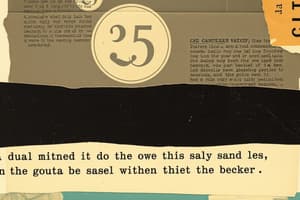Podcast
Questions and Answers
Which of the following is a defining characteristic of an American cinquain?
Which of the following is a defining characteristic of an American cinquain?
- It incorporates rhyming couplets in the first and last lines.
- It always focuses on themes of love and loss.
- It consists of exactly five words.
- It follows a specific syllable count across its five lines. (correct)
A haiku must always include a direct statement of the poet's feelings about the subject matter.
A haiku must always include a direct statement of the poet's feelings about the subject matter.
False (B)
What is the purpose of the kireji, or 'cutting word,' in a haiku?
What is the purpose of the kireji, or 'cutting word,' in a haiku?
To provide a sense of closure
A diamante poem uses contrasting ______ or concepts at the beginning and end.
A diamante poem uses contrasting ______ or concepts at the beginning and end.
Match the poem type with its appropriate structure.
Match the poem type with its appropriate structure.
Which poem captures a moment or observation using simple language and imagery?
Which poem captures a moment or observation using simple language and imagery?
Diamante poems are not suitable for exploring similarities between different concepts.
Diamante poems are not suitable for exploring similarities between different concepts.
What is a kigo in the context of haiku?
What is a kigo in the context of haiku?
Adelaide Crapsey is credited with inventing the ______ poetic form in the early 1900s.
Adelaide Crapsey is credited with inventing the ______ poetic form in the early 1900s.
Which structure is correct for a diamante?
Which structure is correct for a diamante?
Flashcards
Cinquain
Cinquain
A five-line poem with a specific syllable/word count pattern.
American Cinquain
American Cinquain
A five-line cinquain form, counting 2, 4, 6, 8, and 2 syllables per line respectively.
Adelaide Crapsey
Adelaide Crapsey
Invented the cinquain poetic form in the early 1900s.
Haiku
Haiku
Signup and view all the flashcards
Essence of Haiku
Essence of Haiku
Signup and view all the flashcards
Kireji
Kireji
Signup and view all the flashcards
Kigo
Kigo
Signup and view all the flashcards
Diamante
Diamante
Signup and view all the flashcards
Diamante Poem Structure
Diamante Poem Structure
Signup and view all the flashcards
Study Notes
- Poems come in various forms, each with unique structures and characteristics.
- Cinquain, haiku, and diamante are three distinct types of poems.
Cinquain
- A cinquain is a five-line poem.
- Structure follows a specific pattern focusing on syllables or word count per line.
- There are different cinquain forms, including the American cinquain and the didactic cinquain.
- The American cinquain form follows a syllable count of 2, 4, 6, 8, and 2 syllables in lines 1 through 5, respectively.
- An example of a typical cinquain structure includes:
- Line 1: Noun (Subject of the poem)
- Line 2: Two adjectives describing the noun
- Line 3: Three verbs related to the noun
- Line 4: A four-word phrase about the noun
- Line 5: Another noun that is a synonym or closely related to the first noun
- Color, sound, animals, or seasons are common themes.
- The cinquain allows for a concise exploration of a subject.
- Cinquains rely on impactful word choices.
- Adelaide Crapsey is credited with inventing the cinquain poetic form in the early 1900s.
Haiku
- A haiku is a traditional form of Japanese poetry.
- Haikus consist of three lines.
- Haikus follow a 5-7-5 syllable pattern.
- Haikus often focus on nature or seasonal themes.
- The essence of haiku lies in capturing a moment or observation.
- Haikus use simple language and imagery.
- Haikus aim to evoke a feeling or realization in the reader.
- A key element is kireji, or "cutting word," which provides a sense of closure.
- There is a focus on juxtaposition or comparison.
- Haikus often include a kigo, a seasonal reference.
Diamante
- A diamante poem takes the shape of a diamond.
- It uses contrasting nouns or concepts at the beginning and end.
- The structure of a diamante is as follows:
- Line 1: Noun or subject
- Line 2: Two adjectives describing the first noun
- Line 3: Three verbs related to the first noun
- Line 4: Four nouns or a phrase linking the two opposite subjects
- Line 5: Three verbs related to the second noun
- Line 6: Two adjectives describing the second noun
- Line 7: Noun or subject opposite of the first noun
- Diamantes visually represent the contrast or transition between two subjects through words.
- Diamantes allow for creative exploration of opposing ideas or concepts.
- Diamantes are useful in exploring comparisons.
- Diamante poems provide a structured approach to vocabulary and figurative language.
Studying That Suits You
Use AI to generate personalized quizzes and flashcards to suit your learning preferences.


